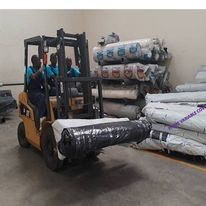Earth dam liners are a crucial component in the construction and maintenance of dams. They play a significant role in preventing water seepage, which can lead to erosion, structural instability, and even dam failure. In this blog post, we’ll explore the various types of earth dam liners, their benefits, and key considerations for choosing the right liner for your project.
Types of Earth Dam Liners
- Geomembranes
- Description: Geomembranes are synthetic membranes typically made from materials like High-Density Polyethylene (HDPE), Linear Low-Density Polyethylene (LLDPE), and Polyvinyl Chloride (PVC).
- Benefits: These liners offer excellent resistance to chemicals, UV radiation, and punctures, making them ideal for long-term use.
- Application: Geomembranes are commonly used in various water containment applications, including earth dams, due to their durability and effectiveness.
- Learn More: Geomembrane liners
- Geosynthetic Clay Liners (GCLs)
- Description: GCLs consist of a layer of bentonite clay sandwiched between two layers of geotextiles.
- Benefits: GCLs provide an excellent hydraulic barrier and are easy to install. They are also self-healing if punctured.
- Application: These liners are suitable for earth dams, landfill covers, and other applications requiring a strong barrier against water seepage.
- Learn More: Geosynthetic Clay Liners
- Compacted Clay Liners (CCLs)
- Description: CCLs are made by compacting clay soil to create a dense, low-permeability barrier.
- Benefits: When properly constructed, CCLs are highly effective at preventing water seepage and are cost-effective.
- Application: CCLs are often used in conjunction with other liner types to provide additional seepage protection.
- Learn More: Compacted Clay Liners
Key Considerations for Choosing Earth Dam Liners
- Soil Compatibility
- The compatibility of the liner with the local soil is crucial. Some liners may perform better in certain soil types than others. For example, geomembranes might be preferred in sandy soils, while GCLs could be more effective in clayey soils.
- Hydraulic Performance
- The liner’s ability to prevent water seepage is paramount. Look for liners with low permeability rates and excellent sealing capabilities.
- Durability and Longevity
- The chosen liner must withstand the environmental conditions of the dam site, including UV exposure, chemical interactions, and potential physical damage. Geomembranes, for instance, are highly durable and can last for decades.
- Installation and Maintenance
- Ease of installation and maintenance can significantly impact the overall cost and efficiency of the dam project. Some liners, like GCLs, are easier to install and repair compared to others.
- Cost Considerations
- While initial costs are important, it’s also essential to consider the long-term costs associated with maintenance and potential repairs. Investing in a high-quality liner might be more cost-effective over the dam’s lifespan.
Conclusion
Selecting the right earth dam liner is crucial for ensuring the safety, efficiency, and longevity of your dam. By understanding the different types of liners and their specific benefits, as well as considering key factors such as soil compatibility, hydraulic performance, durability, and cost, you can make an informed decision that will protect your investment and the environment.
For further reading, check out these resources:
- Geomembrane Liners Overview
- Benefits of Geosynthetic Clay Liners
- Understanding Compacted Clay Liners
By focusing on these key elements, you can ensure that your earth dam project is both efficient and sustainable, providing long-term benefits for your community and the environment.

